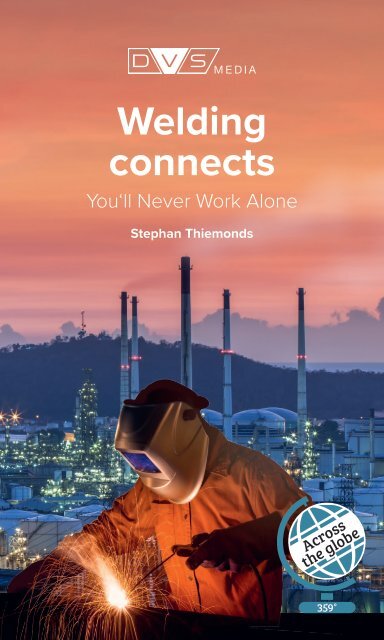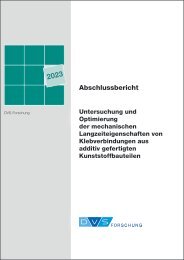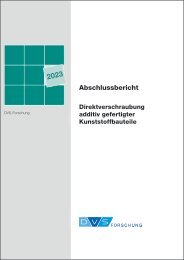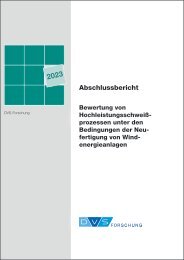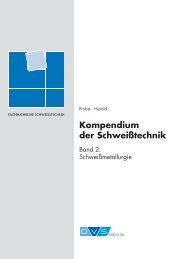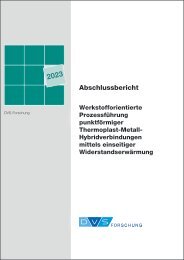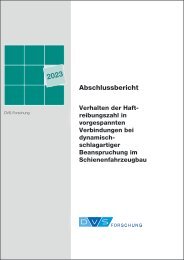You also want an ePaper? Increase the reach of your titles
YUMPU automatically turns print PDFs into web optimized ePapers that Google loves.
<strong>Welding</strong><br />
connects<br />
You‘ll Never Work Alone<br />
Stephan Thiemonds<br />
Across<br />
the globe<br />
359°
<strong>Welding</strong> connects! Metals and people. Professionally and privately.<br />
Locally and globally.<br />
The author, an educated coppersmith and welder, discovers and<br />
experiences this welding phenomenon again and again during his<br />
professional world travels. Written in the style of Magical Realism<br />
and based on technical and factual knowledge, he tells the story<br />
of welding technology in an entertaining conversational tone. How<br />
and why welding connects; why the healing power of singing while<br />
welding in the middle of a narrow copper pipe brought him as far as<br />
Singapore; from an Antarctic storm night aboard a krill fishing vessel<br />
that was separated, lengthened and welded back together; why<br />
ten little sewage sludge dryers and the archangel Raphael have a<br />
welding connection; and why the return of the Jedi Knights is critical<br />
to the future of welding technology. Surprised by the phenomenon<br />
associated with his profession, that welding not only connects, but<br />
can even fulfill children‘s dreams: through the magic of the welding<br />
industry!<br />
Exceptional reading for industry insiders. Fascinating insights into<br />
the world of welding technology for all industry outsiders.
This book is written by HW (Human Welder), without<br />
the help of AI (Artificial Intelligence).<br />
“<strong>Welding</strong> connects.<br />
Metal and people.<br />
Locally and globally.<br />
Simply phenomenal!”<br />
Internationally valid welding wisdom
Stephan Thiemonds<br />
<strong>Welding</strong> connects<br />
You’ll never work alone
Bibliografic information published<br />
by the Deutsche Nationalbibliothek<br />
The Deutsche Nationalbibliothek lists this publication in<br />
the Deutsche Nationalbibliografie; detailed bibliografic<br />
data are available on the internet at http://dnb.d-nb.de.<br />
Lectorate <strong>Welding</strong> Technology:<br />
Prof. Dr.-Ing. Gerd Kuscher, GSI SLV Hannover,<br />
Achim Hauspurg (SFM), Üdingen<br />
Cover Design by DVS Media, Düsseldorf, Germany.<br />
Inspired by Christian Banpao, Chonburi, Thailand<br />
Copyright Cover: anek.soowannaphoom/Shutterstock<br />
Nuamfolio – stock.adobe.com<br />
robert – stock.adobe.com<br />
TechSolution – stock.adobe.com<br />
ISBN 978-3-96144-197-6<br />
All rights reserved.<br />
© DVS Media GmbH, Düsseldorf 2023<br />
Production: SDL - Digitaler Buchdruck,<br />
Schaltungsdienst Lange oHG, Berlin
Table of Contents<br />
Foreword: <strong>Welding</strong> Technology –<br />
a Field for Creative Minds ............................................ 1<br />
Foreword by the Gesellschaft für Schweißtechnik<br />
International – Schweißtechnische- Lehrund<br />
Versuchsanstalt Hannover, Germany....................... 3<br />
<strong>Welding</strong> connects ........................................................... 5<br />
The healing Power of Singing while <strong>Welding</strong> ............. 14<br />
In Seventh Heaven ..................................................... 120<br />
Mr. Smith and the Thing about Experience ............... 129<br />
The Return of the Jedi Knights .................................. 134<br />
Quick and painless ..................................................... 177<br />
We love the Storms, the roaring Waves ..................... 226<br />
What would the World be without Steel? .................. 280<br />
The Magic of Industry ............................................... 293<br />
Ten small sewage Sludge Dryers and<br />
the Archangel Raphael ............................................... 315<br />
The stainless Steel Thing ........................................... 338<br />
<strong>Welding</strong> connects –<br />
and fulfils Children’s Dreams .................................... 364<br />
You’ll Never Work Alone! ......................................... 382<br />
Take Me Home, Country Roads ................................ 384<br />
The Story Behind 359° .............................................. 389<br />
Sincere Thanks! ......................................................... 391<br />
List of References ...................................................... 395
Foreword: <strong>Welding</strong> Technology – a Field for<br />
Creative Minds<br />
The author acquired his knowledge in Germany. His<br />
professional career is a striking example in the welding<br />
branch: A solid foundation through vocational basics and<br />
advanced training by a dual training system, followed<br />
by international projects worldwide. Exactly like the<br />
DVS – Deutscher Verband für Schweißen und verwandte<br />
Verfahren e. V. (German <strong>Welding</strong> Society) offers with its<br />
training facilities and vocational variants as one of the<br />
great career options.<br />
DVS Media as a subsidiary of DVS – Deutscher Verband<br />
für Schweißen und verwandte Verfahren e. V. is particularly<br />
delighted to publish Mr. Thiemonds’ stories now<br />
also in English.<br />
In his book the author tells in his very personal and unique<br />
way about former projects and his personal encounters<br />
around the world.<br />
His narrative style is inspired by popular culture, like<br />
comics and movies, develops an irresistible suggestive<br />
pull within the professional reader as well as in those<br />
without welding experience, who learn as a pleasant side<br />
effect something about welding and its methods. The<br />
author shares his inner and exterior experience with the<br />
reader. The literary ʻwelding fillerʼ is a good sense of<br />
ʻMagic Realismʼ, interweaving and joining the individual<br />
chapters. Imaginations running wild, but always with the<br />
heartbeat in welding, and furthermore, in engagement in<br />
humanitarian projects like the construction of a school in<br />
Southeast Asia.<br />
1
Not fairy tales told by a welder, not a prank, the stories<br />
are well-founded experience reports, told in a thrilling<br />
way and spiced-up with a good sense of positive thinking<br />
about the world, connecting with people with the same<br />
technical and human mindset. In one of the vividly told<br />
stories about copper tube welding you’ll get to know<br />
about the connection between welding and the healing<br />
power of singing! Showing how to approach and realize<br />
awesome projects together and to grow personally from<br />
this challenge.<br />
For sure, this entertaining and illuminating book by our<br />
ʻmetallograph-philosopherʼ will find a lot of avid readers<br />
around the world. You highly value technique, adventure,<br />
and creativity speeded-up by imagination? – Then you<br />
will love every page of this book!<br />
Uta Tschakert<br />
DVS Media GmbH<br />
2
Foreword by the Gesellschaft für<br />
Schweißtechnik International – Schweißtechnische-<br />
Lehr- und Versuchsanstalt Hannover<br />
(GSI SLV), Germany<br />
Anyone whose mind was once captured by welding technology,<br />
especially laser welding, you can’t get away from<br />
it.<br />
This also happened to the author of this book. His basics<br />
come from conventional welding technology with a solid<br />
education. In his stories he explains in a generally understandable<br />
way what steel is in all its configurations and<br />
how welding technology joins steel. It was deliberately<br />
not intended to be a purely scientific treatise, although all<br />
the statements are technically sound. In addition to all his<br />
practical experience through his worldwide use, the laser,<br />
which joins steel by means of light, plays a major role,<br />
whereby the steel reacts differently in laser beam welding<br />
than is generally known.<br />
Fascinated by this technology, I got to know Stephan<br />
Thiemonds through the company DSI Laserservice<br />
(Thailand), as well as its owner, Mrs. Thongplew Banpao<br />
and the Technical Director, Mr. Thanapol Pradissun. For<br />
many years, I have been auditing DSI Laserservice (Thailand)<br />
for certification according to DIN EN ISO 3834-2.<br />
Through my visits and our cooperation on site, I can<br />
very positively evaluate and recommend the professional<br />
skills of this company. Their qualification and knowledge<br />
benefits all customers of DSI Laserservice (Thailand).<br />
Both at their main location in Chonburi and in the branch<br />
offices. And furthermore, also during mobile laser beam<br />
welding operations on site at the customer’s premises,<br />
3
which is easily possible thanks to the modular, easy-totransport<br />
laser welding systems.<br />
Stephan Thiemonds and the DSI Laserservice (Thailand)<br />
laser specialists know that the possibilities and applications<br />
of a laser beam are far from exhausted. Which in<br />
turn spurs them on to work on innovative further developments<br />
that will ultimately benefit all users of laser<br />
technology, accompanied by the phenomenon of the parttime<br />
welder writing being inspired by his everyday work<br />
to continue to report entertainingly on welding technology<br />
and beyond the industry in future publications.<br />
Based on the industry-related fact that welding connects.<br />
Prof. Dr.-Ing. Gerd Kuscher<br />
Auditor and Accredited Certification<br />
GSI SLV Hannover<br />
4
<strong>Welding</strong> connects!<br />
This simple fact is based on countless proofs. One is<br />
this book that you are holding in your hands right<br />
now. Admittedly, the cover and the pages in between<br />
were not joined together by welding, but by the joining<br />
method ʹgluingʹ described in DIN 8593-8. However, this<br />
book and the stories it contains would simply not exist<br />
without the ʹweldingʹ process described in DIN 1910-<br />
100. Which would not be tragic. But a pity. After all,<br />
this book stands as proof of the fascination associated<br />
with welding. Because welding – attention! – connects<br />
in a double sense: steel and people. Locally and globally.<br />
Isn’t that fantastically!<br />
But before I tell you about the big world of welding<br />
technology out there, I would like to tell you something<br />
small, from inside me: how this book came about.<br />
Even if it should give the impression, there is no wellthought-out<br />
concept behind it. Based on the economically<br />
threatening shortage of skilled workers in Germany, to<br />
increase the attractiveness of welding professions in<br />
an entertaining way. Nor did this book originate from<br />
a beer-social whim with my colleagues in a smoky bar<br />
in Bombay, Bangkok or Butzbach. Inspired by chatting<br />
about old times and deeds done, while someone in the<br />
group euphorically exclaims, Hey, guys, let’s write a history<br />
book about this! This idea excites me, but it doesn’t<br />
hit the real trigger. It merely proves my talent for imagination.<br />
Rather, the trigger I am getting at came very suddenly:<br />
in the form of an emotion popping up. Triggered by an<br />
external circumstance. Detached in a split second. As if<br />
someone had pulled the plug, the emotion – whoosh! –<br />
triggered a flood of inspiration that swept me away, my<br />
body and soul. I experienced a full-body rush of feelings,<br />
ideas, memories and constructs. Coupled with a portion<br />
of digressive fantasy. Based on a solid foundation of factual<br />
and technical knowledge.<br />
5
6<br />
This horny mix of emotions that lasted far longer<br />
than the orgasm experienced in the wildest dreams of<br />
my youth with Brooke Shields (* 1965), – Aahhh! –<br />
together in The Blue Lagoon of Nanuya Levu, – Aahhh!<br />
– damn! What was I trying to tell, anyway? Oh, right.<br />
I was overcome by this very book emotion in a similarly<br />
paradisiacal place in spring 2014: in Thailand.<br />
But unfortunately, not during an erotic bath in front of<br />
a lagoon waterfall. But during working hours. When I<br />
was commissioned by my boss to supervise the repair<br />
of two thin-film evaporator rotors with the experienced<br />
eye of a European welding expert. When the customer<br />
informed me during the initial meeting that the cracks<br />
would not be repaired by the conventional TIG welding<br />
process, as I had originally thought of on the outward<br />
flight above the clouds. Instead, by a laser! That was<br />
the emotion-triggering signal word, whereupon my fantastic<br />
journey into the world of laser welding technology<br />
began. Musically accompanied by the unmistakable Star<br />
Wars opening melody.<br />
“Ta Ta, Ta-da-da Ta, Ta-da-da-da Ta, Tadadada ...”<br />
The rest is history. To be read, in the laser story told<br />
in this book, The Return of the Jedi Knights. I wrote it<br />
while I was still at the DSI in Thailand. After my return<br />
home, this same laser story led me to the Jedi Knight for<br />
further research, Attention! – <strong>Welding</strong> connects – to the<br />
Jedi Knight C. F., at Maulbronn, Baden-Württemberg.<br />
To the Master Yoda of laser welding technology at that<br />
time. To the managing director of the DSI Laserservice<br />
Germany. To his lovely assistant Mrs. Kuzma, to the<br />
bright Mr. Hocke and to other colleagues of his team.<br />
To the, in my eyes, Laser masters of the Universe, who<br />
are fighting for the Good Force. Do laser welding with<br />
courage, discipline and know-how all possible and all<br />
impossible types of steel. Using the fantastic technology<br />
of pulse laser welding, which inspires me to write about<br />
it. With all its unbeatable advantages over conventional<br />
welding processes. Almost without welding distortion
and without changes of microstructure. Narrated in the<br />
story of the same name: Quick and painless.<br />
Another proof that welding connects in a double sense<br />
is my professional boat trip to Antarctica. From Uruguay<br />
to the place where I thought I had fallen out of the world.<br />
Back then, in 2009, on the Norwegian krill trawler Juvel.<br />
On board: two horizontal dryers, each weighing 70 tons.<br />
Designed and built by my colleagues at Buss-SMS-Canzler<br />
workshop in Butzbach. To dry the krill caught in the<br />
Antarctic Ocean, which is immediately processed into<br />
powder on the high seas: into krill flavor. For frozen<br />
pizzas, for example.<br />
For the purpose of plant commissioning, I went<br />
on board with my SMS colleague Ralf in Montevideo.<br />
With him, I moved into a – Attention! – <strong>Welding</strong> connects<br />
especially in the smallest of spaces – a tiny, yet<br />
very cozy cabin with even a porthole. Right at the front<br />
of the ship. Knowing well that a few months earlier the<br />
original boat named Perangi had become the Juvel: in a<br />
colossal transformation at the MWB shipyard in Bremerhaven.<br />
In their dry dock, the Perangi was cut and pushed<br />
apart. After the two krill dryers and other krill processing<br />
machines had been brought below deck and pre-installed,<br />
a nearly 40 meters long, newly manufactured hull section<br />
was placed precisely in the gap. Whereupon all three<br />
hull sections, bow, middle section and stern were pushed<br />
together and, watch out! – <strong>Welding</strong> connects! – were<br />
united in a material bonded manner. By means of two<br />
circular welds running all around the fuselage. Voila! The<br />
transformation of the 60 meters short Perangi into the<br />
99 meters long Juvel was complete.<br />
With this background knowledge, plus my further education<br />
as a European welding expert, who knows from<br />
his own welding experience what undiscovered weld<br />
defects lie dormant in weld seams and what they can do<br />
under alternating stress, we got caught in an Antarctic<br />
storm one night. For hours, the Juvel fought against ten<br />
meters high killer waves. Bow first. Together with my<br />
7
8<br />
colleague and me in our bunks. Steeply we went up the<br />
wave crest. Feet first. High up, at the crest of the wave,<br />
the Juvel paused for a split second. As if she was delaying<br />
the unstoppable on the tipping edge. It took courage –<br />
and then, as a mass of several thousand tons of steel,<br />
plunged into the wave canyon. To fall after ten meters<br />
of free fa- Ahhhh! -ll hit the concrete-hard surface of the<br />
water, Wroommm! – while I stayed in my bunk, frozen<br />
stiff with fear. I clung with both hands to the boards on<br />
the side of my thin mattress, while I pursued only one<br />
thought for hours.<br />
I hope the welds withstand!<br />
Wroommm! –<br />
I hope the welds withstand!<br />
Wroommm! –<br />
Which weld defects lay dormant in the hull joints of the<br />
Juvel, how they got in there and how they were covered<br />
up by the quality department just to meet the deadline for<br />
the hull extension, and whether the welds even held back<br />
to the safe harbor of Montevideo, is revealed in the sailor’s<br />
story, We love the Storms, contained in this book. By<br />
the way, I also sang the pirate song of the same name<br />
of the Bündische youth movement 1 , which I learned as a<br />
little scout at the campfire, on that stormy night. I sang<br />
for hours. While outside, in the pitch dark and surrounded<br />
by icebergs, the sea raged, the waves reared up – to sink<br />
the Juvel with its 52 men strong crew. To avenge the billion-fold<br />
death of the defenseless inhabitants of the Arctic<br />
Ocean, to avenge the krill we had caught and pulverized.<br />
Wroommm! –<br />
To be honest, I wasn’t singing because I enjoyed the<br />
ship-like up-and-down movements. No, no. On the contrary!<br />
I sang to drown out the dark voice of my fear. And<br />
to banish the film of revenge and weld failure haunting<br />
my mind:<br />
“We love the storms, the roaring billows<br />
of the ice-cold winds rough face.
We have sailed so many seas<br />
and yet our flag has not sunk.”<br />
Both as a scout and as a temporary sailor, singing the<br />
chorus loudly gave me the greatest joy. It gave me the<br />
greatest feeling of happiness and thus the least fear of the<br />
big, wide, dark and freezing world outside:<br />
“Heio, heio, heio, heioheioheioho, heiho, heioho,<br />
heiho.”<br />
Just by writing that one line of song, I feel that<br />
pleasant euphoric tingle again. Which leads me recklessly<br />
to reveal to you already that the Juvel did not sink<br />
due to the revenge of the White Krill, nor due to covered-up<br />
welding defects. I’m sure you’ve already figured<br />
that out for yourself, because you have the proof in your<br />
hand right now. If the Juvel had broken apart on the night<br />
of the storm, five days’ voyage from the nearest coast,<br />
the idea I had for the We love the Storms story, which<br />
was born in my bunk when the Juvel hit the surface of<br />
the water, would certainly be lying at the bottom of the<br />
sea now.<br />
Wroommm! –<br />
I would like to use the depth of the last sentence to<br />
advance to the basis of all human and metallic welded<br />
joints. To the material necessary for this: steel. To this<br />
extremely important material that we can no longer<br />
imagine life without today: these miracle-performing<br />
metal alloys of which there are more than 2,500 types<br />
and whose main component is always iron. Before I go<br />
into rapture, which is rather frowned upon in our industry<br />
because it is neither masculine nor standardized, I’ll<br />
quickly come to the worst-case scenario: if there were no<br />
steel, welding would not be able to connect. Neither the<br />
material nor us humans. Which would not only be a pity<br />
in a double sense, but very tragic.<br />
Wroommm! –<br />
Because in a world without steel, my colleagues and<br />
I would be out of a job. We would not only have nothing<br />
9
10<br />
to weld, but also nothing to laugh about. There would be<br />
no thin film evaporators and no krill fishing ship Juvel.<br />
(Which should make the krill very happy, at least.)<br />
There would be no DSI at Thailand, no MWB shipyard<br />
in Bremerhaven, and not even a single, last – oops!<br />
I almost wrote Mohican instead of – which leads me to<br />
the inspiring thought: The last steel worker. – Doesn’t<br />
sound so bad after all. I’ll keep it in mind as a novel<br />
idea. The core of the plot: the long-term preservation<br />
of Germany’s steel industry base in the face of rapidly<br />
emerging, underground competition from Russia, India<br />
and China, which are forming themselves into modern<br />
economical powers.<br />
Back to the facts: Steel is of elementary importance.<br />
Not only for Germany or Europe. For the entire<br />
world. Especially for that of men. Because in a man’s<br />
world without steel, we could neither steel ourselves nor<br />
become as hard as the steel cast at Friedrich Krupp AG<br />
in Essen. Instead of such personality development – from<br />
youth to iron man – we would have to find our way in<br />
the classic male role: as a real German oak. Which, however,<br />
is female by its word type, i.e., its gender word in<br />
traditional German grammar: the oak. Moreover, it has<br />
34 fewer chromosomes than a human being. So why<br />
become a real German oak? To regress in the course of<br />
becoming a man? From 46 chromosomes back to 12? –<br />
Anyway, doesn’t matter.<br />
The main thing is to be a guy like a typical German<br />
heraldic tree. Single-sex, with a strong, towering trunk<br />
and rough bark; a wide-spreading crown that defies<br />
every storm; bearing pendulous inflorescences in spring<br />
and dense deciduous foliage in the middle of the year;<br />
easily recognizable by its fruit: the acorn. Throughout<br />
its long life, the German oak remains faithful to its<br />
God-ordained place in life. With increasing age, it<br />
reverently bends its branches down to its roots. To the<br />
place from which the crown once sprouted. What a real<br />
German oak has to do until someone comes along, cuts
down the indomitable, chops it up and burns in the stove<br />
what has grown slowly over many decades. –<br />
Whoever as a man cannot or does not want to withstand<br />
this classic symbol for eternity, that of the genuine<br />
German oak, could take up residence in Munich’s<br />
motherhouse: the hotel Deutsche Eiche. To warm up<br />
there in the sauna from the cold-metal world of steel.<br />
Thinking of this alternative makes me glad that Mother<br />
nature made a coppersmith out of me! A real metal guy,<br />
an ironman, albeit with an occasional tendency towards<br />
melancholy. Which is not so bad. Because it passes.<br />
Sometimes it’s even productive! Like, for example, my<br />
melancholic streak in combination with a professional<br />
trip to China. When I asked myself the philosophical<br />
question there in 2009: What would the World be without<br />
Steel? Which in turn gave rise to the story of the same<br />
name, also told in this book.<br />
Joy, beautiful spark of Divinity 2 : fortunately for all<br />
of us (but unfortunately for the poor krill) there is steel.<br />
This we welders join together by welding. Which in turn,<br />
as we know, results in human relationships. Because<br />
welding connects. Sometimes consciously, sometimes<br />
surprisingly. Anyone can get caught. And anywhere. You<br />
just have to get involved. To the person. To the welding.<br />
To the steel. Whether local or global. It doesn’t matter.<br />
But always phenomenal.<br />
Having pretty much reached the end of this introductory<br />
narrative, I am once again left with nothing but<br />
hope. Similar to that time, the Antarctic storm night. But<br />
this time my hope is not directed at Zeus and his brother<br />
Poseidon; not at the patron saint of welders and the<br />
patron saint of the sea. No, this time my hope is for you,<br />
dear reader. In the sense that I hope you will immerse<br />
yourself body and soul, whole-body and holistically, in<br />
the following welding stories. Which I would be particularly<br />
pleased about if you do not, I repeat and put it<br />
in capital letters for the sake of importance, if you are<br />
NOT a native of welding. But nevertheless, let yourself<br />
11
e infected by the subject matter and carried away by the<br />
pull of the stories.<br />
And maybe even, not to say hopefully, you will fall<br />
for the fascination of welding while reading. – From<br />
one moment to the next you feel fantastic. Included in a<br />
global community. Closely connected in harmony. You<br />
will feel a pleasantly tingling, aphrodisiac feeling of<br />
connection that will stay with you for a long time. Long<br />
after you have gently closed this book at its end in serene<br />
composure. –<br />
If that’s the case, then hooray! Then my very first emotion<br />
that overcame me back then in Thailand, at the signal<br />
words laser welding, was not only doubly but triply<br />
worthwhile. Because this book, thanks to your added<br />
sense of connection, takes on a hitherto undreamed-of<br />
dimension: a third! Because it is proof that welding also<br />
creates interdisciplinary connections. The best example<br />
is: <strong>Welding</strong> even fulfils children’s dreams! This fantastic<br />
story is also told in this book.<br />
<strong>Welding</strong> connects! You, and me, and somehow all of<br />
us. That’s how Mother Nature intended it for us. And this<br />
is how the poet of the German Enlightenment, the mastermind<br />
of the new self-confidence of the bourgeoisie,<br />
Gotthold Ephraim Lessing (1759 – 1805), wrote it.<br />
“In nature everything is connected with everything<br />
else; everything crosses itself, everything changes<br />
with everything else, everything changes, one into the<br />
other.”<br />
Wroommm! –<br />
Across the world somewhere on the way,<br />
in spring 2023<br />
12
Endnotes<br />
1 German elitist youth movement after Word War I with focus on<br />
the male ideal of a knight and the medieval orders of knights,<br />
supporting a lifelong brotherhood of the carefully selected members.<br />
2 Joy, beautiful Spark of Divinity is the first line of Friedrich<br />
Schiller’s (1759 – 1805) most famous poem, Ode to joy. It was<br />
written in the summer of 1785 and was set to music by Ludwig<br />
van Beethoven (1770 – 1827), among others, in the 4th movement<br />
of his 9th Symphony.<br />
13
14<br />
The healing Power of Singing while<br />
<strong>Welding</strong><br />
Just two years after completing my vocational training,<br />
I was allowed to fly to Singapore on business at the<br />
tender age of 21. Business class above the clouds to the<br />
other end of the world. To the Southeast Asian island<br />
city-state not far from the equator, where – my self-confidence<br />
could hardly believe it – they needed me and my<br />
skills as a coppersmith. Among all my experienced Canzler<br />
3 colleagues, I was the one who received the plane<br />
ticket from the boss. Including his confidence that I was<br />
exactly the right man for this mission. There were two<br />
simple but travel-decisive reasons for this.<br />
First of all, I was slim and slender, in comparison to<br />
my colleagues, who were also capable of copper welding<br />
and were far more experienced. Physically, I did not<br />
correspond to the classic image of a strong coppersmith<br />
who could easily swing a sledgehammer. At least I was<br />
willing. And I knew that although I didn’t have the<br />
strength of an ironman forged from Krupp steel, I did<br />
have the courage of a dreamer. The second reason was:<br />
I was not only learning to weld, but also to sing while<br />
welding. And I did it without being ashamed of it. Thus,<br />
I had two key qualifications – being lanky and able to<br />
sing – that the training framework did not provide for<br />
teaching. This deficiency was my all-important advantage.<br />
Sounds confusing, I know. Almost like an engineer’s-fairytale<br />
like from the Thousand and One Nights.<br />
So, let me tell it to you.<br />
Once upon a time, more than 100 years ago, there was<br />
a master coppersmith named Carl Canzler (1858–1919).<br />
He operated a coppersmithing bearing his name, which<br />
he founded in 1890 and which was located in the north<br />
of the district town of Düren, in North Rhine-Westphalia.<br />
In his work as an apparatus engineer, the entrepreneur<br />
was confronted with the enormous problems of welding<br />
copper. In his search for a welding solution, he combined
his ambitious enthusiasm for research with the tinkering<br />
talents of his employee and Master craftsman, Richard<br />
Samesreuther (1880 – 1946). This clever ʹYou’ll Never<br />
Work Alone!ʹ-teamwork led them to a groundbreaking<br />
invention in welding technology. Patented by the Imperial<br />
Patent Office on October 01, 1912 with the following<br />
wording:<br />
“Process for autogenous welding of copper, using a<br />
phosphorus-containing copper wire as filler material.”<br />
The Canzler wire, named after Carl Canzler’s family<br />
and company name and soon world-famous for its<br />
welding advantages, was invented. But his wire was not<br />
only suitable for welding copper. In contrast to the previous<br />
brazing, it also made acid-resistant welds possible.<br />
Due to the turmoil of the First World War, the paths of<br />
the two patent holders diverged. While Carl Canzler continued<br />
to build up the coppersmith’s workshop in Düren<br />
with the help of his son Heinrich, Richard Samesreuther<br />
went to Butzbach as a 38-year-old returning war veteran.<br />
There, on April 9, 1919, he had the establishment of the<br />
apparatus construction company Samesreuther & Co.<br />
OHG entered in the Commercial Register at the Hessian<br />
District Court.<br />
What no one could have foreseen at that time: In the<br />
following decades and as a result of economic changes,<br />
what once separated was to be reunited. The Swiss steel<br />
and mechanical engineering company Buss AG and Mr.<br />
Müller and Mr. Schuss played a decisive role in the decades-long<br />
reunification. Incidentally, their initials, M<br />
and S, stand for SMS, following the S for Samesreuther.<br />
They were joined by ʹthe Canzlerʹ from Düren, from<br />
which Buss-SMS-Canzler GmbH was finally formed in<br />
2003. This company celebrated its 100th anniversary<br />
on April 9, 2019, on the origins company premises in<br />
Butzbach, thus miraculously closing the circle. As an<br />
15


